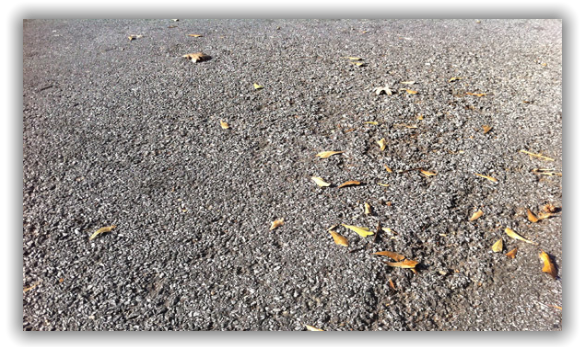by
Roger Smith
| Jun 21, 2016
 Weathering and Seal Coats:
Weathering and Seal Coats:
Weathering is basically the wearing away and loss of the asphalt binder and fine aggregate matrix as defined for distress type 8, Weathering. Since slurry and similar seals are composed primarily of fine aggregate and binder, the wearing away and loss of slurry seals should be considered weathering.
Application of severity levels should be as follows:
L - Asphalt surface beginning to show signs of aging which may be accelerated by climatic conditions. Loss of the fine aggregate matrix is noticeable and may be accompanied by fading of the asphalt color. Edges of the coarse aggregates are beginning to be exposed (less than 0.05 inches or 1 mm). Pavement may be relatively new (as new as 6 months old).
M - Loss of the fine aggregate matrix is noticeable resulting in the exposure of up to 1/4th of the width (of the longest side) of the coarse aggregate in the underlying pavement surface.
H - Underlying pavement surface is exposed showing greater than 1/4th of the width (of the longest side) of the coarse aggregate in the underlying pavement surface.
Note: Loss of seal resulting in loss of coarse aggregate in the underlying pavement surface should be addressed as raveling.
For Raveling and Seals Coats see our Best Practices page in the StreetSaver Distress Manuals.
Oil Spillage
Oil spillage can cause both Raveling and Weathering. If only the fine matrix is damaged or lost, then it would result in Weathering. However, if more than 20 coarse aggregate particles or clusters per square yard (square meter) are lost, then it would result in Raveling.
Application of severity levels for weathering should be as follows:
L - In the case of oil spillage, the oil stain can be seen, but the surface is hard and cannot be penetrated with a coin. Edges of exposed coarse aggregate particles are exposed less than 0.05 inches or 1 mm.
M - In the case of oil spillage, the oil stain can be seen, but the surface is hard and cannot be penetrated with a coin. Loss of fine aggregate matrix is noticeable and the edges of the coarse aggregate particles have been exposed up to 1/4th of the width of the longest side of the coarse aggregate due to loss of fine matrix. Twenty or fewer coarse aggregate particles or clusters per square yard (square meter) have been lost.
H - In the case of oil spillage, the surface is soft and can be penetrated with a coin; however, twenty or fewer coarse aggregate particles or clusters per square yard (square meter) have been lost. Edges of the coarse aggregate particles have been exposed greater than 1/4th the width of the longest side of the coarse aggregate due to loss of fine matrix.
For raveling, the following should be considered in assigning severity levels:
M – In the case of oil spillage, the surface is soft and can be penetrated with a coin, and more than 20 coarse aggregate particles or clusters per square yard (square meter) have been lost.
H - In the case of oil spillage, the asphalt binder has lost its binding effect, the aggregate has become loose, and more than 20 coarse aggregate particles or clusters per square yard (square meter) have been lost. Surface may be very rough and pitted, and it may be completely removed in places.
See these and more helpful hints in our StreetSaver AC and PCC Distress manuals available at: http://streetsaveronline.com/products/Ebooks